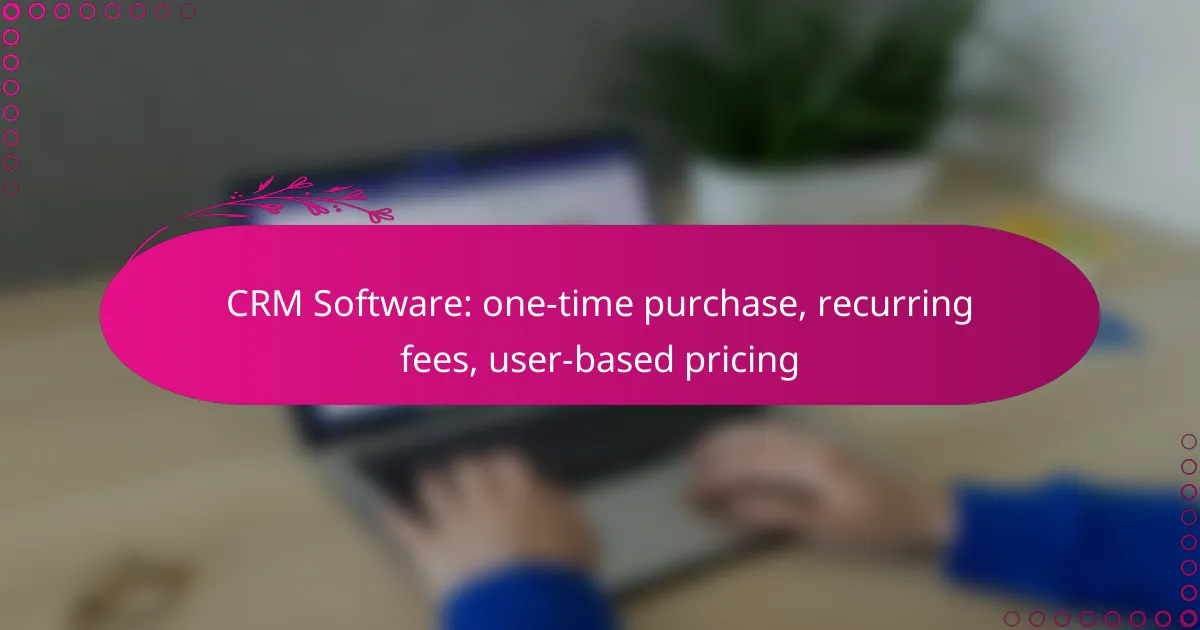CRM software in Canada offers various pricing models, including one-time purchases, recurring fees, and user-based pricing. One-time purchase options allow businesses to avoid ongoing costs while still accessing essential customer relationship management tools. Recurring fees provide continued access to features and support, while user-based pricing enables companies to align costs with their team size, offering flexibility to accommodate different business needs.
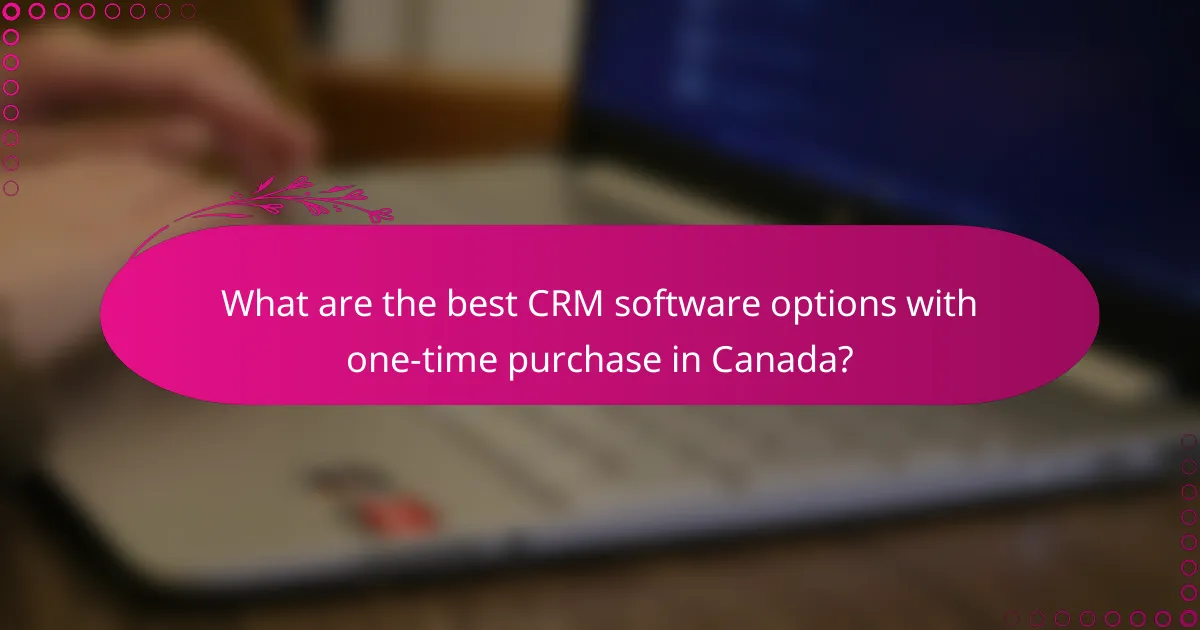
What are the best CRM software options with one-time purchase in Canada?
In Canada, several CRM software options offer a one-time purchase model, allowing businesses to avoid ongoing subscription fees. These solutions can be particularly appealing for companies looking to manage costs while still benefiting from robust customer relationship management tools.
Zoho CRM
Zoho CRM provides a one-time purchase option that is cost-effective for small to medium-sized businesses. The software includes a range of features such as lead management, sales automation, and analytics, making it a comprehensive tool for managing customer relationships.
When considering Zoho CRM, evaluate the initial cost against the features you need. The one-time fee typically covers essential functionalities, but additional features may require extra costs. Ensure you assess your business needs to avoid overspending on unnecessary features.
Salesforce Essentials
Salesforce Essentials offers a one-time purchase option, ideal for startups and small businesses. This CRM solution is known for its user-friendly interface and robust integration capabilities, allowing businesses to tailor the software to their specific needs.
While the one-time purchase can be appealing, keep in mind that Salesforce often encourages users to transition to subscription models for ongoing support and updates. Consider the long-term implications of your purchase decision and whether you might need to budget for future enhancements.
HubSpot CRM
HubSpot CRM is another viable option for businesses seeking a one-time purchase model. It provides essential CRM features like contact management, email tracking, and reporting, all designed to enhance customer interactions.
Although HubSpot CRM is free for basic use, advanced features may require a one-time purchase or subscription. Assess your business’s growth plans and whether the initial investment aligns with your long-term strategy. This approach can help you maximize the value of your CRM investment.
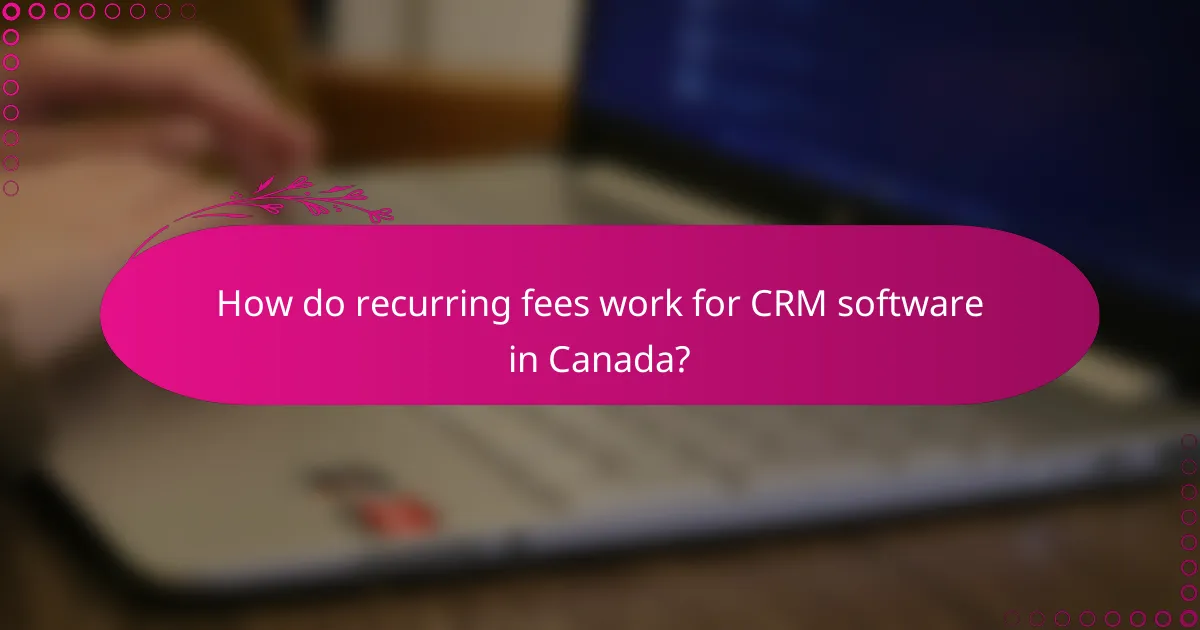
How do recurring fees work for CRM software in Canada?
Recurring fees for CRM software in Canada typically involve monthly or annual payments for continued access to the software. These fees can vary based on the features included, the number of users, and the level of support offered.
Monthly subscription models
Monthly subscription models charge users a set fee every month, making it easier to manage cash flow. Prices can range from around CAD 20 to CAD 200 per user, depending on the software’s capabilities and the vendor’s pricing strategy.
One advantage of monthly subscriptions is flexibility; businesses can scale their usage up or down without long-term commitments. However, over time, monthly payments can add up, potentially exceeding the cost of an annual plan.
Annual subscription savings
Annual subscriptions often provide significant savings compared to monthly payments, with discounts typically ranging from 10% to 20%. For example, a CRM that costs CAD 100 per month might be available for CAD 1,000 annually, saving CAD 200 over the year.
Choosing an annual plan can be beneficial for businesses with stable needs, as it locks in pricing and reduces the hassle of monthly billing. However, companies should ensure they are committed to the software for the entire year to avoid wasting money on unused services.

What is user-based pricing for CRM software?
User-based pricing for CRM software charges businesses based on the number of users accessing the system. This model allows companies to scale their costs according to their team size, making it a flexible option for various business needs.
Per user per month pricing
Per user per month pricing is a straightforward model where businesses pay a fixed fee for each user every month. This can range from around $10 to $100 per user, depending on the features included. Companies should consider their user count and the specific functionalities they require when evaluating this pricing structure.
One advantage of this model is its predictability; businesses can easily forecast their monthly expenses. However, as teams grow, costs can increase significantly, so it’s essential to assess user needs regularly to avoid unnecessary expenses.
Tiered pricing structures
Tiered pricing structures offer different packages based on user count and feature sets, typically categorized into basic, standard, and premium tiers. Each tier comes with a set number of users and varying functionalities, allowing businesses to choose a plan that best fits their requirements. Prices can vary widely, often starting from a few hundred dollars per month for small teams to several thousand for larger organizations.
This model can be beneficial for businesses looking to balance costs with features. However, companies should be cautious of overcommitting to higher tiers without fully utilizing the additional features. Regularly reviewing usage against the selected tier can help ensure that businesses are not paying for unused capabilities.
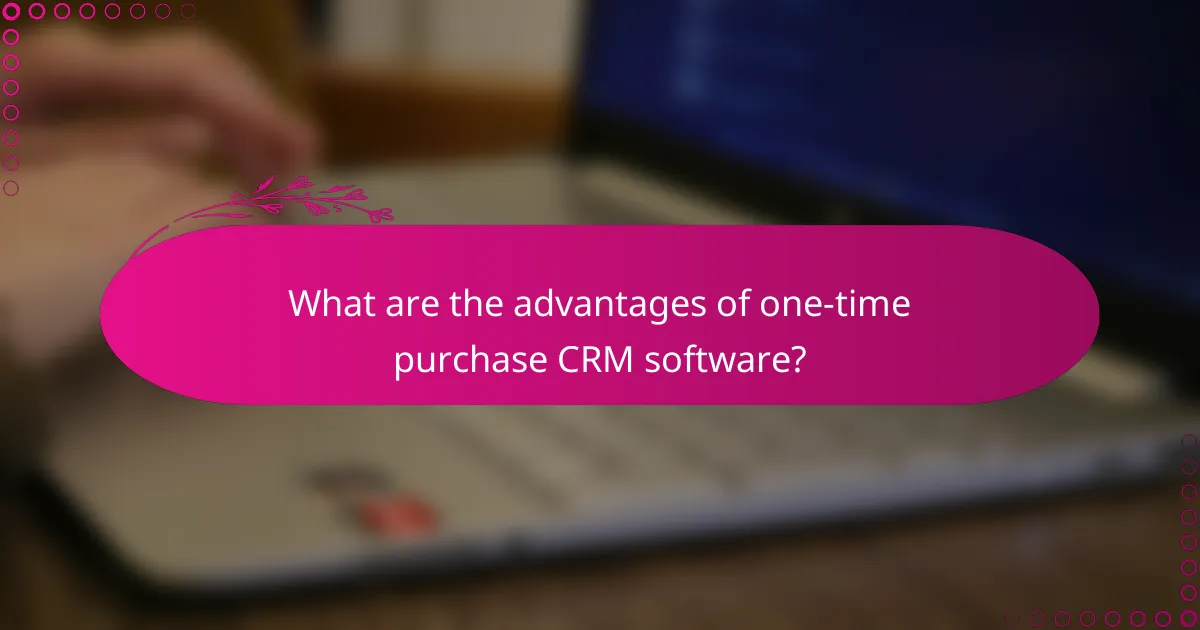
What are the advantages of one-time purchase CRM software?
One-time purchase CRM software offers businesses the benefit of a single upfront cost without ongoing subscription fees. This model is particularly appealing for companies looking to manage their budget effectively while maintaining control over their software assets.
No ongoing fees
One-time purchase CRM software eliminates the need for recurring fees, making it easier for businesses to forecast their expenses. Once the initial payment is made, users can access the software without worrying about monthly or annual charges.
This can lead to significant savings over time, especially for small to medium-sized enterprises that may find subscription models financially burdensome. Additionally, businesses can allocate their budget to other critical areas without the pressure of continuous payments.
Full ownership of the software
With a one-time purchase, businesses gain full ownership of the CRM software, allowing for greater control over its use and customization. This ownership means that companies can modify the software to meet their specific needs without being restricted by vendor limitations.
Moreover, owning the software outright can provide peace of mind regarding data security and compliance, as businesses can manage their data storage and access without relying on third-party servers. This is particularly important for industries with strict data protection regulations.
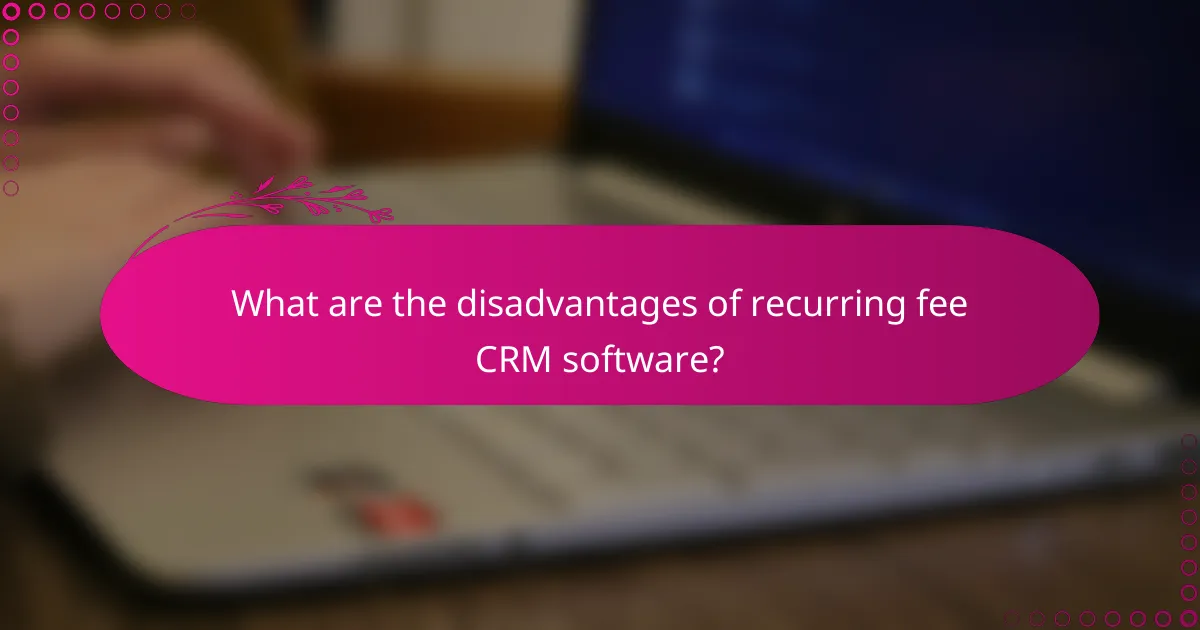
What are the disadvantages of recurring fee CRM software?
Recurring fee CRM software can lead to ongoing costs that accumulate over time, making it potentially more expensive than a one-time purchase. Additionally, users may find themselves reliant on the vendor for updates and support, which can affect their operational flexibility.
Long-term cost implications
While the initial cost of recurring fee CRM software may seem low, the long-term expenses can add up significantly. Businesses should consider that annual fees can range from a few hundred to several thousand dollars, depending on the number of users and features. Over a span of several years, these costs can exceed the price of a one-time purchase solution.
It’s essential to calculate the total cost of ownership over a multi-year period when evaluating CRM options. This includes not only the subscription fees but also any additional costs for upgrades, training, and potential add-ons that may be required as your business grows.
Dependency on vendor support
Recurring fee CRM software often ties users to the vendor for ongoing support and updates, which can create a dependency that limits flexibility. If a vendor experiences issues or discontinues service, businesses may face disruptions that affect their operations. This reliance can be particularly concerning for companies that require consistent access to their CRM data.
To mitigate this risk, businesses should assess the vendor’s reputation for customer support and their track record for reliability. It’s advisable to review service level agreements (SLAs) to understand response times and support availability, ensuring that the vendor can meet your business needs effectively.

How to choose between one-time purchase and recurring CRM software?
Choosing between one-time purchase and recurring CRM software depends on your business’s long-term goals and cash flow. One-time purchases typically require a larger upfront investment, while recurring fees spread costs over time, allowing for easier budgeting.
Evaluate business needs
Assess your business needs to determine which CRM model aligns best with your operations. If your organization requires extensive customization or has a stable user base, a one-time purchase may be more beneficial. Conversely, if your needs are likely to evolve or you anticipate fluctuating user numbers, a recurring model may offer the flexibility you need.
Consider the scale of your operations. For smaller teams or startups, a subscription model can reduce initial costs and provide access to updates and support without significant financial risk. Larger enterprises may prefer a one-time purchase to avoid ongoing fees, especially if they have a predictable user count.
Consider budget constraints
Your budget plays a crucial role in deciding between one-time purchases and recurring fees. A one-time purchase may strain cash flow initially but can be more cost-effective in the long run if your business remains stable. On the other hand, recurring fees allow for manageable monthly or annual payments, which can be easier to integrate into operational budgets.
Evaluate the total cost of ownership for both options. With a one-time purchase, factor in potential future costs for upgrades and maintenance. For recurring fees, ensure that the total over time aligns with your financial projections. A common pitfall is underestimating the cumulative cost of subscriptions, which can add up significantly over several years.
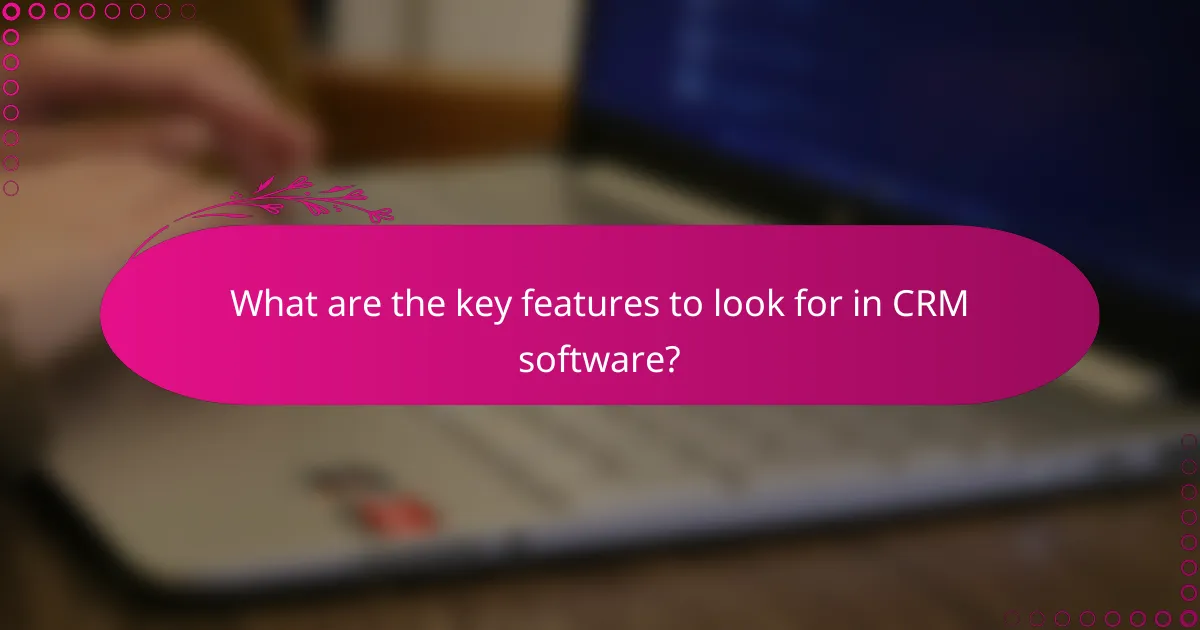
What are the key features to look for in CRM software?
When selecting CRM software, prioritize features that enhance customer relationship management, such as integration capabilities, user interface, and user experience. These elements significantly impact usability and the overall effectiveness of the CRM in supporting your business processes.
Integration capabilities
Integration capabilities are crucial for CRM software as they determine how well the system can connect with other tools and platforms your business uses. Look for software that can seamlessly integrate with email, marketing automation, and accounting systems to streamline workflows and data sharing.
Consider whether the CRM supports popular APIs or has built-in connectors for commonly used applications. A good integration can reduce manual data entry and ensure that your team has access to real-time information across various platforms.
User interface and experience
The user interface (UI) and overall user experience (UX) of CRM software can greatly influence adoption rates among your team. A clean, intuitive UI allows users to navigate the system easily, reducing the learning curve and increasing productivity.
When evaluating CRM options, prioritize those with customizable dashboards and easy access to key features. User-friendly design can enhance engagement and encourage your team to utilize the software effectively, leading to better customer management outcomes.
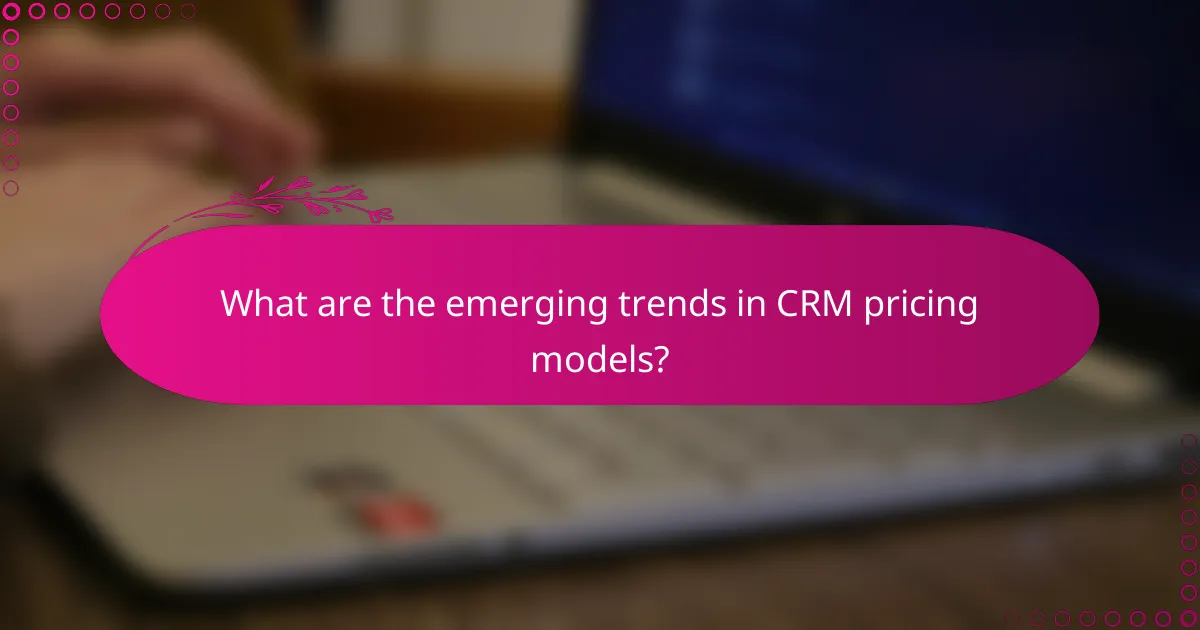
What are the emerging trends in CRM pricing models?
Emerging trends in CRM pricing models reflect a shift towards flexibility and user-centric approaches. Businesses are increasingly adopting models like usage-based pricing, which aligns costs with actual usage, and user-based pricing, which scales with the number of users accessing the software.
Usage-based pricing
Usage-based pricing charges customers based on their actual usage of the CRM software, making it a cost-effective option for businesses with fluctuating needs. This model allows organizations to pay only for what they use, which can be particularly beneficial for startups or companies experiencing seasonal demand.
When considering usage-based pricing, evaluate how your team interacts with the software. For instance, if your CRM charges per contact or per transaction, estimate your average monthly activity to determine potential costs. This model can range from a few cents per transaction to several dollars, depending on the service provider.
Be cautious of potential pitfalls, such as unexpected spikes in usage leading to higher costs. To mitigate this risk, set usage limits or establish a budget to monitor expenses closely. Additionally, ensure you understand the pricing structure and any additional fees that may apply to avoid surprises in your billing cycle.
